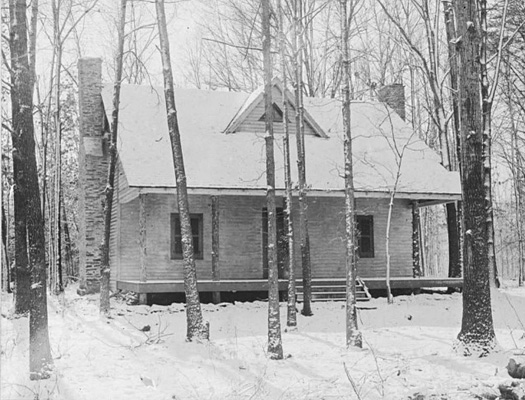Name: Scottsville's Christmas Traditions by Ruth Klippstein
Date: ca. 1906
Image Number: Theodore Roosevelt Collection, Harvard College Library, Roosevelt Class No. 560.52 1906, Shelfmark TRC-PH-3
Comments: In Scottsville and the surrounding area, in the mid-19th century, calling "Christmas gift!" was a beloved custom.
When two people met, the first to say "Christmas gift" would win a present from the other, a coin or similar small token. Grandparents,
parents, husbands--and, in antebellum days, slaveholders--were expected to lose this game, and children were always the winners. Thomas
Jefferson describes his grandson calling "Christmas gift!" in 1809.
Susan Hill Dunn, in her ca. 1934 typescript of memories from 1860's Scottsville, says, "At Christmas-time, there was a race to reach friends'
houses and catch them with "Christmas gift" first, a custom borrowed from slaves, who flocked into the house on Christmas morning to claim their
gifts."
"For us, there was no giving attached to it, only the race to be first. And it was a race; we were up long before daylight, and as soon as
we dressed, we raced up the hill unless our friends ran down first."
Dunn, born into Scottsville's prominent James Christian Hill family (he was wounded in the Civil War), tells of growing up in Reconstruction-era
Scottsville, making do and making their own fun, including the noisy merry-making of the holiday. The old (and much reviled by the English
Puritans) customs of misrule, wassailing, and mumming--all sorts of "fooleries"--gradually declined during the nineteenth century, but were alive
in Scottsville when Dunn was a girl.
"We had a way of drying bladders at hog-killing time, and when blown up and burst, they'd make an astounding noise. Whoever was first at
Christmas burst the bladders on the front porch, and this was the beginning of a noisy fracas. The boys would collect boxes and scrap
lumber on Christmas Eve and pile it with kerosene to make it burn. My brother, Jim, was the leading spirit in our fun�"
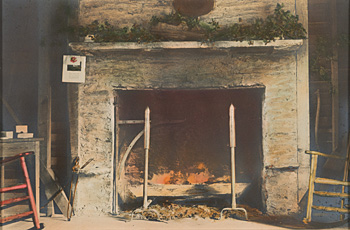
The fireplace interior of Pine Knot, near Keene, VA, in 1906.
Photo from the Theodore Roosevelt Collection,
Harvard College Library. 560.52 1906-075
"Gifts," Susan Dunn concludes "had a small place in my recollection of Christmas. I expect they
were a scanty lot compared with the beautiful gifts that Santa leaves with the children of today, but value had no meaning for us, and I am sure
we were contented and happy as any children ever were."
In nearby Palmyra, Eva Terrell Landford remembers, around 1886, "Christmas was a delight to us. I looked forward to it from one year to
the next, which seemed to be endless. How well I remember stockings hung in a row on the mantelpiece. They were filled with practically
the same kind of things each year. In the toes would be an apple, an orange, a handful of sugar plums (we called them raisins), a few nuts,
some candy, and a toy. One Christmas, I got a lovely china-headed doll. She had black hair painted on and blue eyes. I loved
her dearly and named her 'Lelia.' We couldn't have been happier than we were then." (Source: Jane R. Berkley, Fluvanna County Historical
Society, in an undated "Saber," Fork Union Military Academy)
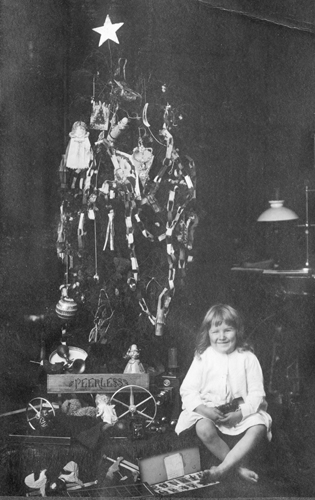
Harold Burgess enjoying his Christmas presents in 1911.
A 1911 photo that William Burgess took of his son, William Harold Burgess, shows the young boy sitting
happily with Christmas gifts spread at his feet including a toy wagon, wooden toys, and a doll.
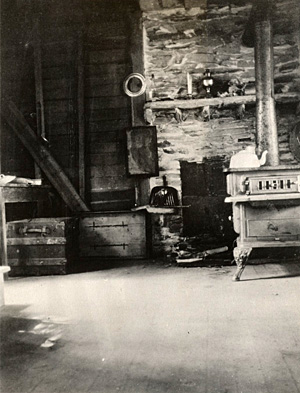 The wood stove in the kitchen at Pine Knot, 1905-1909.
The wood stove in the kitchen at Pine Knot, 1905-1909.
Pine Knot was the retreat of Theodore Roosevelt and his
family during his second administration and his first full
term as president. Photo from the Theodore Roosevelt
Collection, Harvard College Library; R500.R67-108
President Theodore Roosevelt came to Scottsville during three Christmas seasons: 1905, 1907, and 1908.
The family came by train from Washington to North Garden, then proceeded by carriage the ten miles to Pine Knot. Roosevelt's' rustic retreat near
Glendower Church (now 711 Coles Rolling Road, formerly Rt. 712). Edith Roosevelt had purchased this basic house, built by a friend, William Wilmer
of nearby Plain Dealing, as a farm worker's cottage. She had it altered to accommodate the family, adding a porch and two end chimneys, and
creating three small bedrooms on the second floor. Eventually the Roosevelts owned 90 acres surrounding Pine Knot, including the spring from which
they got water. There was no plumbing in the house. Theodore Roosevelt loved it, calling it "A perfectly delightful little place."
But the president was a busy man. Described by John RandolphPhillipss in Of Town and the River as "a Republican, sure, but
welcome, just the same. Not a conventional Republican, but a Republican with almost the shape and marking of a Democrat," Roosevelt hammered
out the treaty for the Panama Canal, being sure the United States had control, in November 1903; a treaty with Cuba in December of that year; activity
in the Dominican Republic and Venezuela in the winter of 1904 and 1905; and mediated peace between Russia and Japan in the same years, for which he
was awarded the Nobel Peace Prize on December 10, 1906. Then the youngest president in our history, he brought what the Encyclopedia Britannica
calls a "new life style" to the White House--along with his six children--and to the office of President, where he often sidestepped the conservative
Republican-dominated House and Senate by issuing executive orders in a wide range of interests.
Did the family feel escape from the press of national and international affairs when they came to Pine Knot after Christmas in Washington?
Did they nail stockings on the mantle, open more presents, or did they just relax and enjoy the woods? Roosevelt showed his affection to his
children, Theodore, Kermit, Edith, Archie, Quentin, as well as Alice, from his first marriage, and indulged and encouraged their high spirits.
The Miller Centerweb sitee on the American President says "for TR, his family was like having his own private circus....He taught the boys to box and
the girls to run, told ghost stories and tales of his own cowboy life out West."
It's easy to imagine these activities at Pine Knot, lit by fire or candles. Electricity had come to the White House Christmas in 1895,
when Grover Cleveland had the president's tree decorated with electric lights, but there were no such amenities in rural southern Albemarle County.
One can imagine some evergreen boughs and locally-collected mistletoe, but no decorations would have been mass-produced. The Christmas tree,
brought into prominence in England and America by the German influence of Prince Albert, would have been left behind in Washington. Commercial
Christmas cards had been popular since the1840'ss in America, and new carols we still love being written and sung in the1860'ss and1870'ss. In 1904,
The Landlord's Game, a predecessor of Monopoly, was popular, possibly interesting the trust-busting president; in 1907 a popular toy was Meccano; and
in 1908, the last year the Roosevelts were at Pine Knot during the holidays, it was Plasticine.
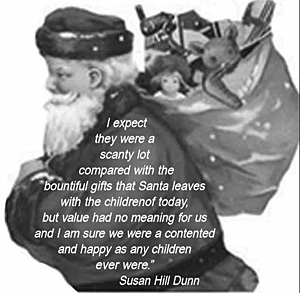 As the effect of Charles Dickens' 1843 "Christmas
Carol" was growing and influencing the way the holiday was understood and celebrated, America was giving a new image to Santa Claus.
Thomas Nast, a political cartoonist of the Civil War period, who invented the Democratic donkey and Republican elephant, used memories of his
native Germany to create a kindly, fat, jolly gift-bringer with a wide black belt and furs. The image has stuck, though Southern children
might have wondered why Nast depicted Santa Claus, draped in the Federal Stars and Stripes, bringing Christmas cheer to Union troops only. As the effect of Charles Dickens' 1843 "Christmas
Carol" was growing and influencing the way the holiday was understood and celebrated, America was giving a new image to Santa Claus.
Thomas Nast, a political cartoonist of the Civil War period, who invented the Democratic donkey and Republican elephant, used memories of his
native Germany to create a kindly, fat, jolly gift-bringer with a wide black belt and furs. The image has stuck, though Southern children
might have wondered why Nast depicted Santa Claus, draped in the Federal Stars and Stripes, bringing Christmas cheer to Union troops only.
Louise Clack addressed this problem in her 1869 children's book, "General Lee and Santa Claus." She has Lee tell four unreconstructed
Rebel girls, who ask him why they haven't seen Santa in four years, that he sent Santa to sell all the gifts in Baltimore and use the money to
buy medicine for sick and wounded Confederate soldiers; "it will be all right with the children," Lee tells them he promised.
Nast's work, at least in the North associated Christmas with family reunions, a yearning for loved ones and gave it a sentimental cast that
is still current. This attitude seems to be appropriate for the Teddy Roosevelt, who wrote in 1904 to hissecondd child, "I tell you,
Kermit, it was such a comfort to feel�when affairs looked doubtful, that no matter how things came out, the really important thing was the
lovely life I had with Mother and you children, and that compared to this home life, everything was of very small importance from the
standpoint of happiness." Some of this home life, lived at Pine Knot, now owned by Roosevelt Pine Knot Foundation, surely encompassed
a lot of Christmas cheer.
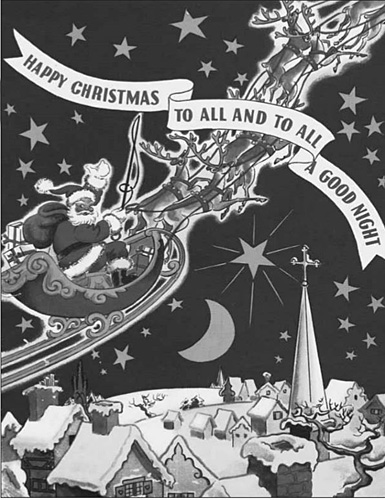
To learn more about Christmastime in Scottsville, read the following article by Ron Smith, which was
published in the Scottsville Monthly in December 2018:
Christmas Memories in Scottsville
By Ron Smith
Scottsville Monthly
December 07, 2018 - January 10, 2019
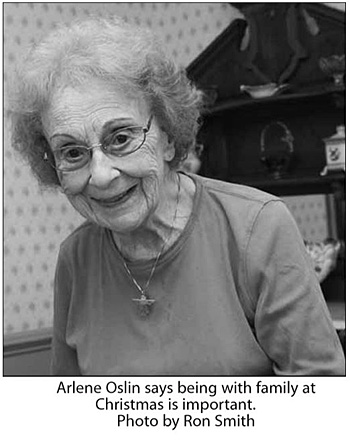 Memories are the one thing we have that no one can take away from us. All through our lives we accumulate thousands; some we forget, but
a lot we remember. It's funny how as you get older you may forget something in the short term but remember every detail of an event or
lyrics to a song from half a century ago. The Christmas holidays provide a great source of memories, the majority of which are usually good.
Memories are the one thing we have that no one can take away from us. All through our lives we accumulate thousands; some we forget, but
a lot we remember. It's funny how as you get older you may forget something in the short term but remember every detail of an event or
lyrics to a song from half a century ago. The Christmas holidays provide a great source of memories, the majority of which are usually good.
Arlene Oslin grew up in Schuyler as an only child. When she graduated from high school, she was not quite 18, and many employers of that
day did not want to hire anyone under that age. A family friend, Charlie Ware, secured her a position with the Virginia Telephone and Telegraph
Company in Charlottesville. She later worked for the local stone company, married her husband, Jimmy, a union that would last 62 years, and
moved to Buckingham.
Arlene secured an office position at Scottsville High School in 1961. After the high school closed, Arlene worked in the office at Scottsville
Elementary school always, "trying to do my best to be a good example to the children with the way I dressed and the way I conducted myself." She
retired in 1991.
Christmas to Arlene meant family. Each Christmas was spent with her mother, father, and grandmother, even after she was an adult. Santa always
found her grandmother's house and somehow knew that Arlene would be there. She loved dolls, collected dolls, and was always excited to find that
Santa had brought her one. Of course there was an occasional pair of socks and whatever grandmother found in the back room to give her as a present,
but the homemade oyster stew they had for Christmas Day dinner was truly memorable.
You might think an only child would be spoiled and expect a ton of gifts, but Arlene was different. Her philosophy is simple: "You don't always need
presents to make Christmas special," she says, "being with your family and the ones you love is the important thing." How right she is!
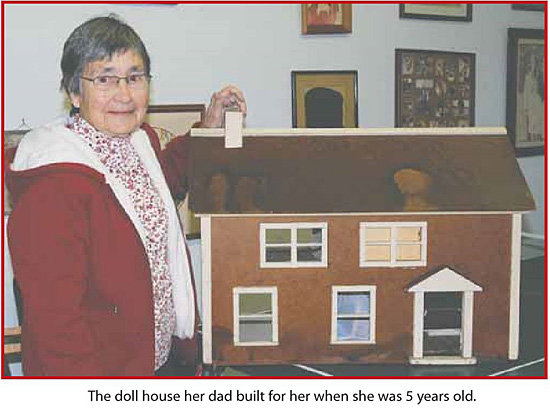 Judy Brown (shown above) grew up in northern Ohio, near Toledo, and it was cold and snowy in the winter.
She has several special Christmas memories, like the Christmas she was sick, and the family doctor made a house call to treat her on Christmas Day.
When she was five, Judy received a doll house her father made and which she still has today. Each piece of furniture was separately wrapped.
At 10, she wanted a piano and remembers hearing a noise outside after she went to bed that Christmas Eve. Thinking it was Santa bringing the piano,
it was actually her father with an organ on his back sneaking into the house. The organ had been at a neighbor's home safely hidden away and was
slightly easier to move than a piano.
She remembers the Christmas of 1941 after the attack on Pearl Harbor which she describes as "a hard one." And she remembers her two aunts,
her father's sisters, who lived in town. Christmas presents could not be opened until she had accompanied her father into town to pick up her
aunts and get back to the farm.
Then there was the practice of decorating the tree on Christmas Eve, a tradition that she and her husband, Jim, continued with their own family of
five children. Family is central to Judy. Jim and a son are no longer with us, but the family gathers at Judy's home for Thanksgiving
and Christmas remembering the good times of the past and creating more good times that will be remembered in the future.
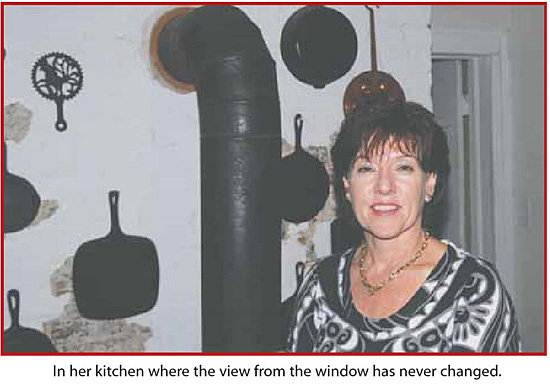 Sallie Massie (shown above) is a Scottsville native. She and her husband, Brandon, live in the
same house in which she grew up. As a matter of fact, she only lived elsewhere after college. When her father's health began to fail,
she moved back home and has been there ever since. As Sallie says, "the view from my kitchen window has never changed!"
Christmas for the Massie clan was to go to Wintergreen to ski and enjoy the snow. One of Sallie's most memorable Christmas's was when
she was seven or eight. The family excursion to Wintergreen was scheduled, but on Christmas Eve there was a heavy snow here in Scottsville.
There was no way the family would be able to make the trek the next day.
The road that passes Sallie's home makes a gentle slope down to the river. With there being so much snow, the family would make their
one "Wintergreen" at home. It helped that Sallie's uncle worked for VDOT and promised to plow that road . It also helped that Sallie's
dad was a builder and access to a gas-powered heater.
So, for much of the day there was plenty of snow to play in, a place to warm up, and lots of cookies and hot chocolate courtesy of her mom.
Sallie, her sister, and the lady at the next house down spent a great Christmas enjoying a present that nature had provided.
"Being with family, decorating, baking and visiting friends," says Sallie, "is more important than a bunch of presents." She is so lucky
to "live in the house she grew up in and be able to think back about all those good times she had and continues to have there.

 Copyright © 2020 by Scottsville Museum
Reference:
"Scottsville's Christmas Traditions" by Ruth Klippstein, Scottsville Monthly, December 16, 2011-January 19, 2012; pp. 8-11; Valley Publishing,
Palmyra, VA.
"Christmas Memories in Scottsville," by Ron Smith, Scottsville Monthly, December 7, 2018-January 10, 2019, pp. 11-12; Valley Publishing,
Palmyra, VA.
Images:
Top Image (Pine Knot Retreat In Snow Near Keene VA, ca. 1906) Located On: Theodore Roosevelt Collection, Harvard College Library; Roosevelt Class No. 560.52.1906-073
Shelfmark TRC-PH-3, HOLLIS number: olvwork542938
Second Image (Pine Knot Interior Fireplace Photo, ca. 1906) Located On: Theodore Roosevelt Collection, Harvard College Library; Roosevelt Class No. 560.52 1906-075,
Shelfmark TRC-PH-3, HOLLIS number: olvwork542940
Third Image (Harold Burgess at Xmas 1911) Located On: Capturing Our Heritage, RB124cd08, Rita Burgess Collection, Scottsville Museum
Fourth Image (Pine Knot Kitchen Stove) Located On: Theodore Roosevelt Collection, Harvard College Library; Roosevelt Class No. R500.R67-108
HOLLIS number: olvwork377315
Fifth Image (Susan Hill Dunn words) Located On: 1934 typescript of Susan Hill Dunn's memories from 1860's Scottsville; Scottsville Museum
Sixth Image (Arline Oslin): Photo by Ron Smith, 2018.
Seventh Image (Judy Brown): Photo by Ron Smith, 2018
Eighth Image (Sallie Massie): Photo by Ron Smith, 2018
|




